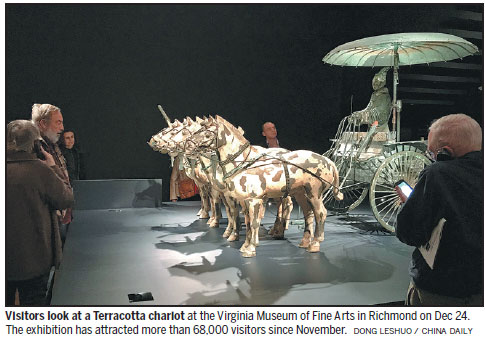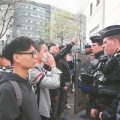China’s Terracotta Warriors, a marvel of the world, have attracted more than 68,000 visitors to the Virginia Museum of Fine Arts in Richmond since its opening in November.
The exhibition – Terracotta Army: Legacy of the First Emperor of China – features 10 majestic terracotta figures, including a cavalry horse, among 130 works that tell the story of China’s birth and the first emperor of China, Qin Shihuang (259-210 BC).
Gathered from 14 museums and archaeological institutes across Shaanxi province, the exhibition also features arms and armor, horse and chariot fittings, ritual bronze vessels, works in gold and silver, jade ornaments, precious jewelry and ceramics.
The exhibition will be shown at the VMFA until March 11, before it moves to the Cincinnati museum. It is the first exhibition that the museum has presented in its 80-year history, which is devoted to the art and archaeology of ancient China. More than 40 objects in the exhibition have never been displayed in the United States before.
“Chinese artists and Chinese culture have been making great art for more than 5,000 years. Americans know so little about the continuum of Chinese art history, how unbroken it is and how magnificent it is. So this is a way for us to show Virginia and America how magnificent the Chinese creative world has been, for millennia”, VMFA director Alex Nyerges said at the opening reception of the exhibition at the Chinese embassy in Washington.
‘Truly remarkable’
The exhibition is divided into three sections: The First Emperor and Unification of China, Birth of the Qin Empire and Quest for Immortality.
“The exhibit is truly remarkable. It puts the Terracotta Warriors in historical context and describes the development of the Chinese culture. The artifacts are displayed beautifully and include decorative items, tools, weapons and architectural pieces. And, of course, the warriors themselves, which are astonishing in their realism. Each is unique, depicting various occupations and having distinct faces,” said one visitor.
“It was fabulous. I was thrilled to see the terracotta soldiers up close and the details of their individual faces. The sampling of the different types of officers and the close-up details of their dress also was very interesting. In China, I saw the whole army in the pit, but you have to stand in a gallery and are too far away to see the details,” another visitor said.
Discovered in 1974 by farmers in China, the underground army of nearly 8,000 life-size terracotta figures is considered one of the greatest archaeological finds of the 20th century.
The Terracotta Army, found about 2 kilometers east of the known burial site of Qin Shihuang, was created to accompany the emperor to the afterlife.



